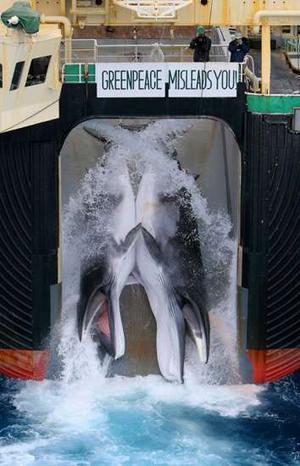 |
| For science & two minke whales are taken aboard a Japanese factory ship in the Southern Ocean. |
THE image flickered across a screen at the International Whaling Commission meeting almost too quickly to catch. Could it be...? Early in the post-lunch session, Japan was dashing through a Powerpoint show of its Antarctic whaling. As hundreds of delegates settled their stomachs, graphs and dot points blinked out of the projector.
Then there it was. A sleek hill of whale, silver belly and grey back, with little helmeted men clambering over it. They looked like Lilliputians with a marine Gulliver. It was a fin whale, harpooned by the Japanese.
The fin whale, the second-largest animal in existence after the blue whale, are built like trains - up to 27 metres long, and able to propel their 127-tonne bodies as fast as 25 knots. "They are a fast-moving, wide-ranging animal of the deeper seas," says Mark Simmons, the science director for the Whale and Dolphin Conservation Society. "They have evolved to travel far, and go for a long time without food. And they are very hard to actually see."
Fin whales are rarely sighted off Australian coasts. They are an endangered species, after 720,000 were killed in the southern hemisphere after World War II. At that time they formed the mainstay of Antarctic industrial whaling, boiled down for oil and later selected by Japanese whalers for their meat. Today there is no agreed count of their number. But last summer Japan began killing them again in its scientific hunt and this was the first time the result had been seen publicly.
The Powerpoint slide carried two blurry images. The first showed four men working around the abdomen of the whale beneath a gantry on the deck of the factory ship Nisshin Maru. One climbed a ladder to hold up a measuring tape. Another crouched on top of the body. The second image showed a group of men holding the opened stomach of the whale, and heaving buckets of krill into a big tub. The slide's conclusion was that fins eat krill exclusively in Antarctic waters.
~~Adz:Left~~This finding was not new. But the slide was a chink of light on the fin kill. Japan has refused to yield data about this hunt. It is a precursor to the 2007 kill of Australian humpbacks, yet its scientists refused to say whether it was even able to kill these whales quickly.
The slides were watched closely by new delegates to the commission, such as Mali's Hercou Libaly. In his sub-Saharan nation, whales are strangers. Yet Mali's votes have become vital to the whales' future.
A few hours after the slide show, the whalers ended 25 years of defeats at the commission. By one vote they passed the St Kitts and Nevis Declaration on "normalisation" of the whaling commission. It declared the moratorium was "no longer necessary", and said the commission should cease to be a whale protection organisation. Instead, the 33 ~~Adz:Right~~countries who backed it wanted a return to the sustainable use of whales.